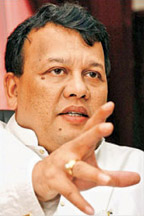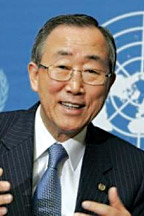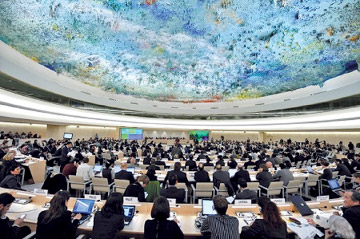Resolution against Sri Lanka at UNHRC: did the US go too far?
Don WIJEWARDANA
In March, the UN Human Rights Council (UNHRC) passed a United States
sponsored resolution pressing the Sri Lankan government to investigate
alleged human rights violations during the final stages of the war with
the terrorist group Liberation Tigers of Tamil Eelam (LTTE). Secretary
of State Hillary Clinton said in a statement immediately after, “United
States and the international community had sent a strong signal that Sri
Lanka will only achieve lasting peace through real reconciliation and
accountability.”
 |
 |
 |
| Minister
Mahinda Samarasinghe |
UN
Secretary General
Ban ki Moon |
US
Secretary of State Hillary Clinton |
Sri Lanka, which rescued 300,000 hostages held by the LTTE as a human
shield, by defeating the terrorist group, has continued to protest at
the allegations of human rights violations. Special envoy on human
rights, Mahinda Samarasinghe, condemned the resolution as “misconceived,
unwarranted and ill-timed”, and potentially harmful to the progress
being made within the country.
The LTTE, in its brutal reign of three decades killed an estimated
100,000 and brought ruin to the once resilient economy. Western
governments warned President Mahinda Rajapaksa not even attempt to fight
the invincible terrorist group, which had mastered the use of female
suicide bombers to cause widespread damage. But following a four-year
gruelling war the LTTE was defeated in May 2009. It was the first time
in recent history that a terrorist group had been so comprehensively
beaten by a government. But not a single Western government moved to
congratulate Sri Lanka for the unparalleled feat.
LTTE cadres
As one Indian commentator noted ‘If such an outcome were to be
secured in Iraq or Afghanistan or even in Pakistan, it would be embraced
by the West as an unadulterated and righteous triumph. In Sri Lanka,
however, it appears to have provoked, .... a seething and barely
concealed outrage... There is a sense, not of a dreaded terrorist
organization having been defeated and destroyed, but of collaborators,
comrades, and fellows at arms, lost to the enemy.
US position seems ironic since it provided considerable help for the
government to defeat the terrorists. US was one of the first countries
to ban the LTTE and the FBI described it as the world’s deadliest
extremist organization surpassing Al-qaeda or HAMAS. Many Tamils
convicted for attempting to buy sophisticated arms and equipment in the
US are currently languishing in jails mostly as a result of FBI sting
operations.
Following the United States, the European Union and India as well as
a number of other countries had proscribed the LTTE. Some of these
governments, especially the US and the UK, also provided arms and
intelligence to help crush the group.
And with the end of the war Sri Lanka has achieved comprehensive
peace. Few countries in the world have been able to restore normalcy
with such speed following a long drawn out war. In under three years
almost all the 300,000 internally displaced people have returned to
their own homes. Even more impressive is that 90 percent of LTTE cadres
who had surrendered (10,490 of the 11,700) have been freed and reunited
with their families.
Alongside these remarkable achievements tourists who shunned the
country for decades have been flocking back. This follows the New York
Times and a number of travel magazines identifying Sri Lanka as a top
tourist destination after the war. Sri Lankan economy last year recorded
the highest ever growth rate of 8.3 percent. Tamils in the Northern
province who had been herded around as hostages by the LTTE have at last
settled back in their own homes. Economic growth of the Northern region
last year was a massive 22 percent. It is clear Sri Lanka, and the
Tamils in particular, are working to leave the past behind and move on.
In that background it is not surprising that they saw the UNHRC
resolution as a hindrance, not a help.
Besides all these, Sri Lanka is a functioning democracy friendly
towards the West.
 |
|
UNHRC
session in Geneva. File photo |
Why then did the United States sponsor the Human Rights Council
resolution against a friendly nation?
Darusman report
The Darusman report to UN Secretary General Ban ki Moon endorsed a
figure noting “there is still no reliable figure for civilian deaths,
but multiple sources of information indicate that a range of up to
40,000 civilian deaths cannot be ruled out at this stage”.
Darusman committee did not undertake its own research but went by the
‘number of sources that quoted the figure’. In other words it had become
a victim (and a promoter) of Goebbels theory that if you keep repeating
a lie people will eventually come to believe it.
The manner in which ‘multiple sources for the information’ that
formed the basis of the Darusman report were mustered should have
alerted the media to their authenticity. By the deadline of December 15,
2010 the response to the committee’s invitation for submissions was so
poor that it had to extend it by two weeks.
It was then that the anti-Sri Lankan lobby got into action urging the
Tamil Diaspora to make representations to pressure the UN to hold an
enquiry against GOSL, even if they hadn’t been directly affected by the
conflict and atrocities.
To make it easy, two dozen sample letters to be sent online to the
Panel of Experts were presented in three different websites. To make it
even easier, to hide their identities, organizers extracted an
undertaking from the UN which denied access to material in the Expert
Panel’s possession for a period of 20 years. Even after the lapse of the
20-year-ban, the Office of Legal Affairs (OLA) has assured the
Committee, that it could give an undertaking to its sources of absolute
confidentiality in the subsequent use of information. Sri Lanka has
criticized the report based on unsubstantiated, third hand sources with
the 20 year embargo which prevents anyone from checking the authenticity
of the information.
There is no data even on how many of the complainants were in fact in
the warzone during the period. In spite of the contrived nature of the
‘evidence’ the media has latched on to the report as the source of
40,000 deaths. The Darusman report negated its own conclusions by noting
later that, “This account should not be taken as proven facts, and any
effort to determine specific liabilities would require a higher
threshold”. But when its numbers were used by the media such
qualifications were conveniently lost in transition.
The British Channel 4 produced a video ‘Sri Lanka killing fields’ to
buttress these claims. Sri Lanka continued to object to these claims and
produced its own documentary ‘Lies Agreed Upon’ which questioned the
authenticity of the Channel 4 presentation. Much of the channel 4
material had been drawn from the LTTE mouthpiece TamilNet that routinely
published exaggerations to drum up Western help and sustain Diaspora
support.
To be continued
Courtesy: Foreign Policy Journal
The writer is an economist, author and a freelance journalist.
[email protected]
|



